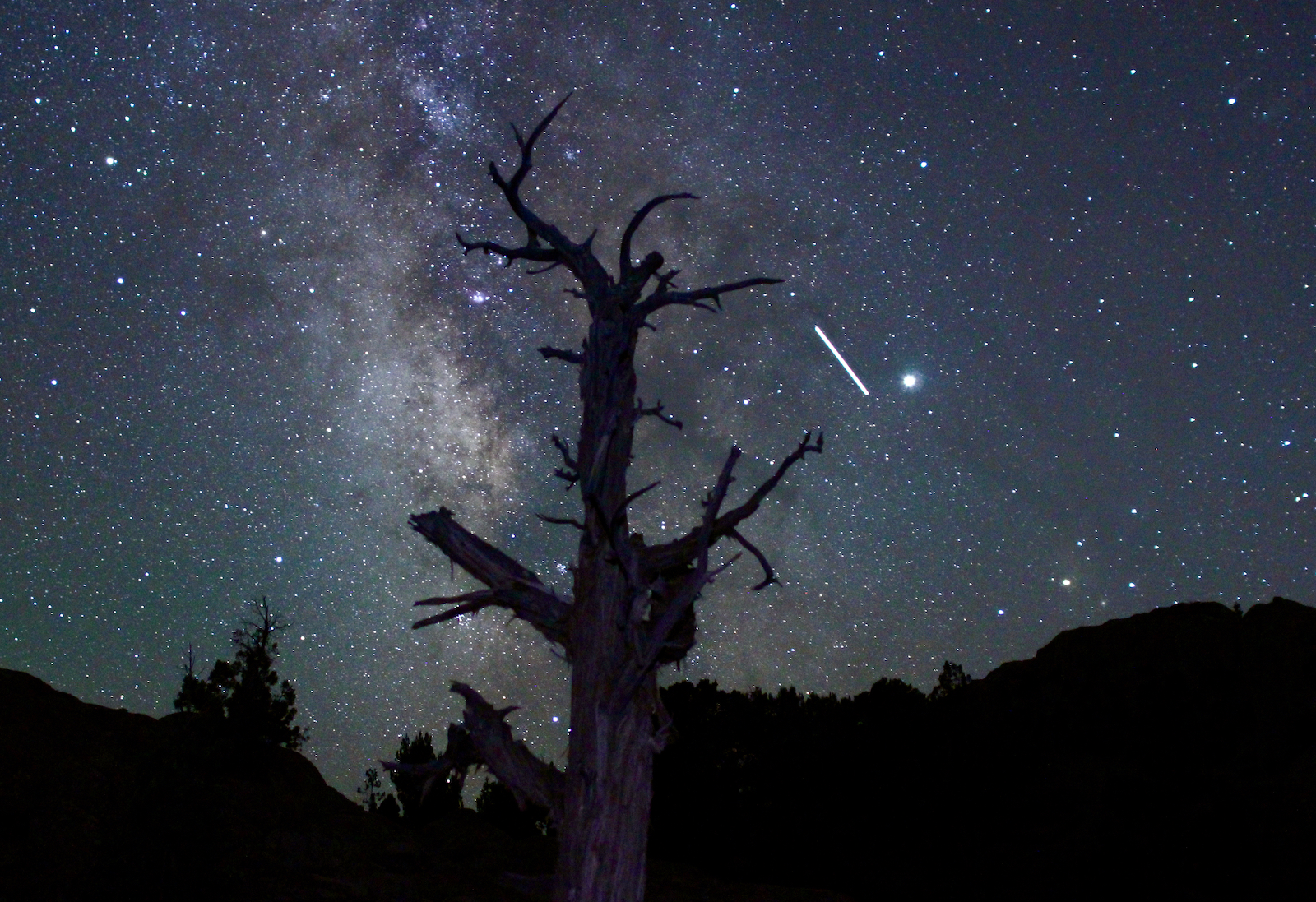Stargazing guide
by space author Peter McMahon, general manager, The Jasper Planetarium
There couldn’t be a better time than now to explore the night sky from your backyard, or anywhere you’re able to be.
To get you started, here are five “can’t-mess-it-up”-easy things for you to find in the next few nights, followed by five slightly more challenging destinations to explore:
5 EASIEST THINGS TO SEE IN THE SPRING SKY
1. Meteor showers – There’s nothing like catching a shooting star (the “wolverines of the sky” as the local First Nations call them.) And unlike almost anything else in astronomy, you don’t need any special gear or even knowledge to see them. Just look up!
Depending on the meteor shower (there’s one or more almost every month), shooting stars will appear to originate from one point, but they’ll appear at almost any place in the sky during each shower’s peak.
Check out our handy guide on how to watch a meteor shower, below:
HERE’S A GUIDE TO TIMES AND DATES FOR ALL ANNUAL METEOR SHOWERS
No need for a telescope or binoculars here- In-fact the ONLY way you can reliably see shooting stars is by just looking up at the sky with your eyes and waiting to see them.
For more on what causes meteor showers and how to watch them, check out our handy video guide, above.
2. Big Dipper

If you’ve ever felt bad about not being able to find the most basic constellation, here’s your chance to increase your knowledge and impress your friends and family who still can’t find it.
In spring, the Big Dipper – a ‘pot’ or ‘spoon’-shaped group of seven stars – is almost directly overhead most times of night from most mid-latitude locations in the Northern Hemisphere.
HERE’RE OUR PICKS FOR STARGAZING APPS TO HELP YOU FIND THE BIG DIPPER AND MORE
The Big Dipper itself is not a constellation – It’s a more basic shape known as an asterism…a sort of crib-note version of a constellation usually made up of only 5-10 stars.
Dozen-or-so stars that extend beyond the Dipper join the Dipper stars to form the legs and head of ‘Ursa Major’, the Big Bear, while the three stars of the handle and four stars of the pot of the Dipper form the bear’s tail and body.
To find the Big Dipper, look almost directly overhead in spring for a ‘box’ of four stars about the dimensions of a shoe-box. That’s the pot of the Dipper. You’ll know it because you’ll see the three bright stars of the Dipper’s handle – evenly-spaced – extending off of one of the corners of this box.
3. North Star
A lot of people mistakenly think the North Star is the brightest star in the sky, which is not the case.
What’s special about the North Star – also known as Polaris – is that it’s lined up with the Earth’s north celestial pole, aligned with the Earth’s axis of rotation – an imaginary line that goes in the North Pole and out the South Pole that our planet rotates on.
As a result, the North Star never appears to move.
If you were at the North Pole, you would see Polaris directly overhead and the same constellations would spin around in the sky all night, year-after-year, forever.
To find the North Star (handy if you’re ever lost and need to know which direction is north) draw an imaginary line between the two stars at the end of the pot of the Big Dipper and continue that line (yellow in our guide here) away from the Dipper (in the direction it would be ‘pouring’ out of) to the next bright star.
That’s Polaris.
4. Venus
person: “What’s that….”
space buff: “It’s Venus.”
person: “No no, hold, on, it’s a bright..”
space buff again: “…Yup, Venus.”
person: “Wait, I haven’t even finishe telling y…”stilll space buff: “Venus.”
person: “……reallybrightlightnearthehorizonatdusk!!..THERE!…[*out of breath*] OK what is it?”
space buff: “Still Venus……….It’s actually Venus.”
person: “Ohhhhhh! OK thanks!”
You may have already known that bright light on the Western horizon at dusk (or eastern horizon at dawn at other times) is the planet Venus (if it’s dimmer, it could be Jupiter…If it’s moving, it’s the International Space Station. But if you are fairly amazed at how bright it is, it’s most likely Venus.)
What you might not know is why Venus is so bright. Here’s that info and some other interesting facts about the hottest planet of all:
Venus is bright because:
- it reflects a lot of sunlight (70% of the sunlight that hits Venus bounces back off it, compared to only 10% for the Moon) BUT because it’s so much closer to the Sun than Earth, most of the heat that does reach Venus stays there
- Venus gets relatively close to us (38 million km at closest approach – similar to Mars and many times closer than Jupiter, Saturn, etc…)
- Venus is larger than the other two rocky planets beyond Earth, just 100 km or so smaller than Earth (almost twice the diameter of Mars and nearly three times the width of Mercury)
Because it’s about the size of Earth but without liquid water, Venus has more land – by-far – than anywhere else in the Solar System.
But despite all that land, Venus isn’t likely to get a 5/5 Tripadvisor review anytime soon: The planet’s surface bakes at nearly 500 C, has 90 times the surface pressure of Earth, and rains sulfuric acid.
If you have a pair of binoculars, you can see Venus a little brighter than with the naked eye, on the western horizon before dusk or the eastern horizon before dawn and maybe start to see it as a disc and not just a point of light. With any telescope, you can see the disc and that Venus goes through “phases” like the Moon.
If you have a telescope and want to look even closer, here’s a great guide to observing Venus in detail.
5. Moon
It’s not so much finding the Moon when it’s in the sky that most people need help with, but rather, finding out what all the cool markings on it are.
After looking and looking, we’ve never really been able to find what we at The Jasper Planetarium feel is a suitable introductory map of the Moon, with enough features labelled to be able to spend a night or two exploring them, but not so many that they’re intimidating to digest, SO we created our own.
Click on the image of our Moon map “Jasper Planetarium edition” for a look at some of the things you can explore with a telescope, binoculars, or just your eyes when it comes to our fascinating, rocky neighbour in outer-space.
Check here for phases of the Moon and rising, setting times. (It’s set for Edmonton, Alberta, but you can change it to wherever you are.)
5 MORE CHALLENGING THINGS TO SEE IN THE SPRING SKY
For a little more challenge (and reward), here are five more objects for you to check-out, in growing difficulty (and coolness). The last one requires at least a pair of binoculars, though a telescope of any size will be even better. The rest require no optical aid at all:
1. Little Dipper
If you’ve already found the North Star (Polaris) from above, you’re almost done finding the Little Dipper already. (If not, we’ll wait while you go do that – see above.)
In addition to being the North Star, Polaris is actually the last star on the end of the ‘handle’ of the Little Dipper.
Just look at the arc of dimmer (then Polaris) stars that stretch out and over from Polaris to form the handle of the Litter Dipper. A box of four dimmer stars at the end of that handle form the pot of the Little Dipper.
The two dippers kind of look like they’re pouring something into each other.
Like the Big Dipper, the Little Dipper is an asterism that’s part of a larger ‘constellation’: in this case, Ursa Minor, the Little (or Lesser) Bear.
Unlike the Big Dipper, the stars of the Little Dipper are dimmer and harder to find among the rest of the stars in a really dark location. (In an urban or suburban location, you’ll actually be able to pick out the Little Dipper easier due to the lack of ability to see even dimmer stars around it.)
2. International Space Station
Sprawling the size of an entire American football field (or, to give you a more Canadian analogy, five NHL hockey rinks), the 400 tonne International Space Station (ISS) is the brightest thing you can see in the evening sky, after the Moon and Venus.
While the ISS doesn’t appear every night, it’s visible from a good portion of the world for a certain number of days each month, as it soars 400 km above the Earth, at 29,000 km/h.
Built-and-crewed by 16 countries (including Canada), the ISS took 10 years and $100 billion USD to construct.
It hosts a crew of six and is currently the largest spacecraft ever put into orbit.
Here’s a handy resource for finding where and when the International Space Station will appear in the sky above where you are (it’s set for Edmonton, Alberta, but you can go HERE to change it to your location and then go back to the homepage and choose “ISS” again to see when it will be above your home.)
BONUS: you can also go HERE to track dozens of other satellites, in case you’re wondering what that light you saw in the sky was.
Check out the video below to see what the ISS looks like in the sky at night:
3. All-aboard the satellite ‘train’
Are they UFOs? Secret military tests? No, but they’re kind of neat to see, in a sort of eerie way.
To be clear, the video below is real. It has not been enhanced or ‘Photoshopped’ – It’s what this really looks like.
What you are seeing (and can see live for yourself in the sky) is a ‘train’ of Starlink satellites. Launched by SpaceX, this ‘constellation’ of dozens of satellites is part of a planned group of thousands of mini-satellites that will be launched into orbit to provide high-quality internet access to millions across the globe.
4. See the biggest star EVER
For the most part, we can’t see the surface of any stars beyond our Solar System. Despite their massive size, they’re just too far.
What we can see is their colour, ranging from white to blue to yellow to orange and red, depending on their temperature. (Blue is typically hottest, while red is least-hot – like the flame of a candle.)
One great example of a red star you can see in the sky also happens to be the largest star visible in the Northern Hemisphere (and the second largest-known star overall): Mu Cephei, also known as the ‘Garnet Star’.
This red-orange ‘hypergiant’ is almost as big as Saturn’s orbit around the Sun, shining 100,000 time brighter than our local star (having said that, it’s also thousands of light-years away.)
To see it, find the constellation Cepheus using the guide above.
Just below the point between the two stars that make up the base of the ‘house’ of Cepheus, you’ll see a dim star that may appear orange or red to your eyes – That’s it!
In a pair of binoculars or through any telescope, the Garnet Star appears red (like the dark-red mineral of the same name) or reddish-orange.
Here’s a size comparison to show just how mind-meltingly-massive this star really is:
5. Two galaxies for the price of one
This is the one you need at least a pair of binoculars for. If you have a telescope, put your lowest-power (highest # in mm) eyepiece in and make sure you’ve got everything focused.
While summer has more than its share of awesome galaxies (more on that in another guide), spring brings with it the unique opportunity to see not one but two galaxies in the same field of view and at a fairly high point in the sky, which provides the clearest potential view.
M81 and M82 (named after astronomer Charles Messier, who popularized them in the late 1700s) are two galaxies that each contain hundreds of billions of stars, both about 12 million light years away (one light year is about 10 trillion km.)
To see them, draw an imaginary line between the lower-left and upper-right stars that make up the ‘pot’ of the Big Dipper. Then keep that line going about as far beyond that last star as the distance between the two stars (see guide image here.)
More-specifically, around this point in the sky, you’ll see a narrow triangle of three dim stars. M81 & M82 are juuuust to the right of the slightly brighter star that forms the elongated tip of this triangle (again, see our guide here.)
In binoculars, you may see two little ‘blobs’ that look like fuzzy stars. In a telescope, move your view around this area of space until you see once fuzzy patch, then move your telescope view around until you see the other, keeping the first fuzzy patch always in the field of view. Assuming you are using the lowest magnification possible with your telescope, you should be able to fit both galaxies in the same view.
Congrats! You are now looking 12 million years in the past. (And space aliens on planets circling any stars in these galaxies would look back at Earth right now and see a variety of prehistoric animals ; )
Hope you get the chance to check out some of these amazing sights in the days and weeks to come!
Questions or comments? Contact us!
Clear skies, guys!

